Analysis of AI, Data Mining, and Text Mining in Business Intelligence
VerifiedAdded on 2023/06/11
|6
|1399
|83
Report
AI Summary
This report delves into the distinctions between data and text mining, highlighting their roles in knowledge discovery, and explores the technologies used in text mining, such as NLP and sentiment analysis, alongside its applications in survey analysis and risk management. It further examines the importance of artificial intelligence (AI) in building smart systems for businesses, focusing on areas like machine learning, security detection, and customer service improvements. The report also addresses the transformative impact of AI on various business departments, including marketing, sales, and manufacturing, while acknowledging the limitations and ethical concerns associated with AI implementation, such as high costs, job displacement, and the potential for data loss, referencing various academic sources to support its claims.
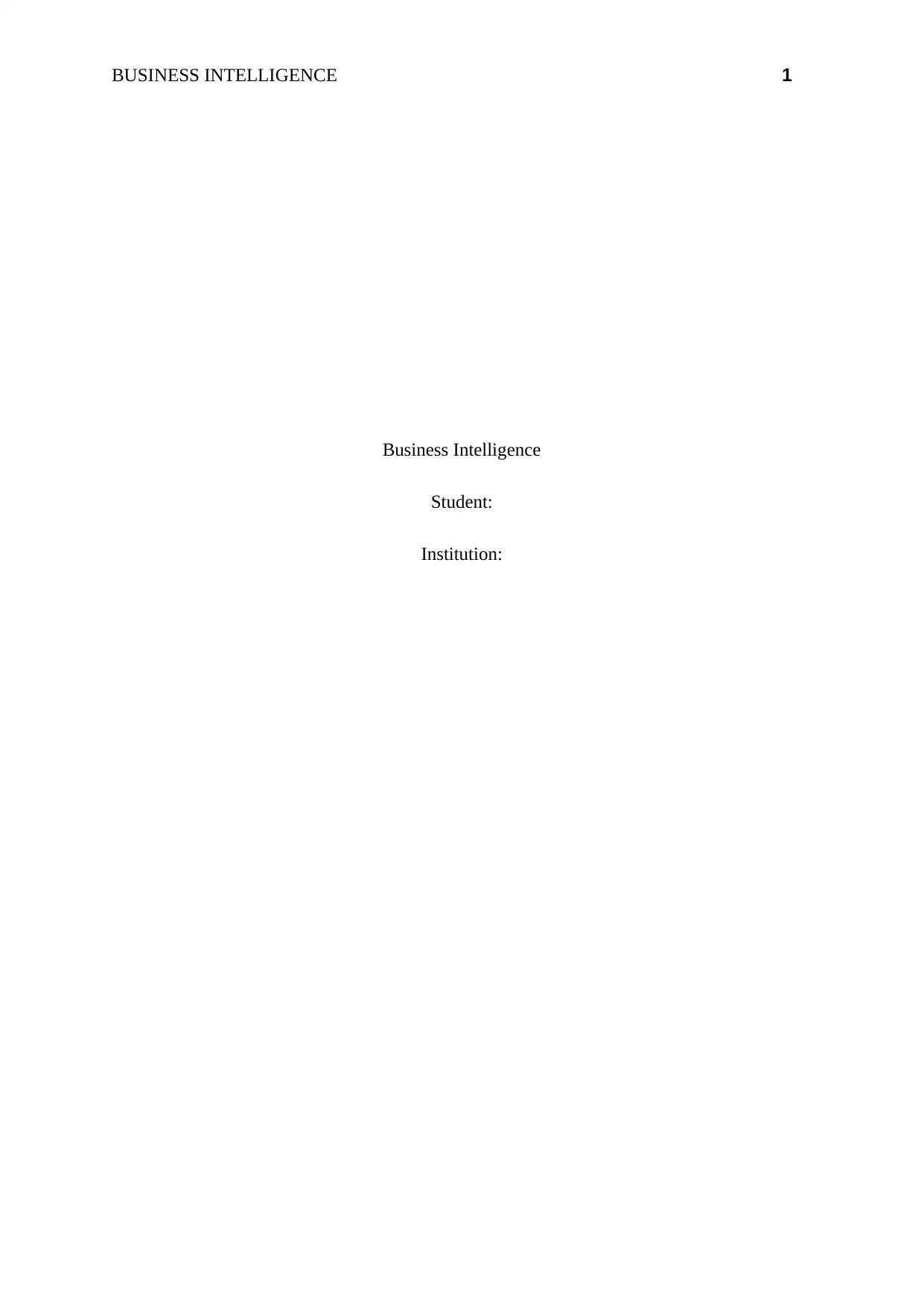
BUSINESS INTELLIGENCE 1
Business Intelligence
Student:
Institution:
Business Intelligence
Student:
Institution:
Paraphrase This Document
Need a fresh take? Get an instant paraphrase of this document with our AI Paraphraser
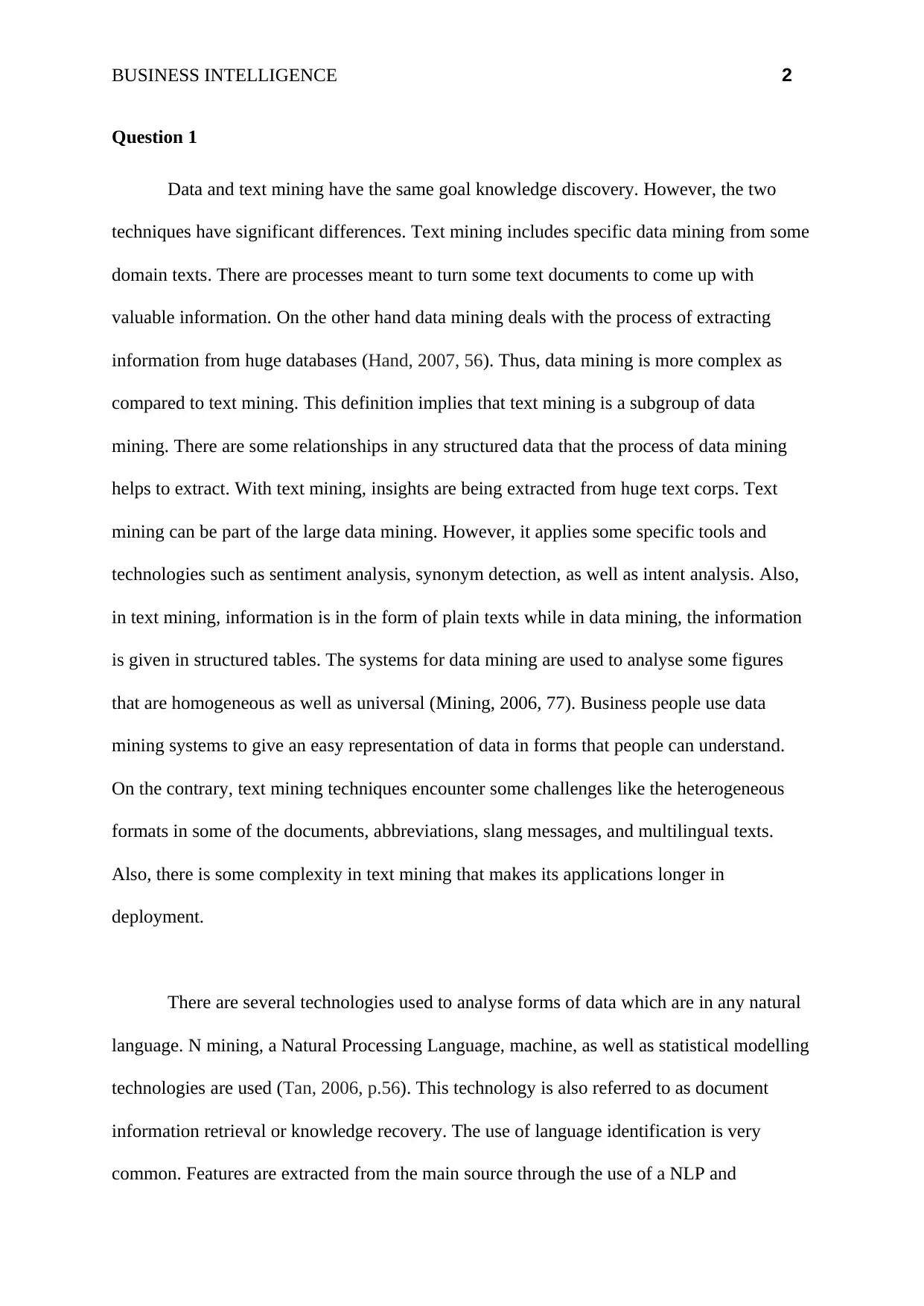
BUSINESS INTELLIGENCE 2
Question 1
Data and text mining have the same goal knowledge discovery. However, the two
techniques have significant differences. Text mining includes specific data mining from some
domain texts. There are processes meant to turn some text documents to come up with
valuable information. On the other hand data mining deals with the process of extracting
information from huge databases (Hand, 2007, 56). Thus, data mining is more complex as
compared to text mining. This definition implies that text mining is a subgroup of data
mining. There are some relationships in any structured data that the process of data mining
helps to extract. With text mining, insights are being extracted from huge text corps. Text
mining can be part of the large data mining. However, it applies some specific tools and
technologies such as sentiment analysis, synonym detection, as well as intent analysis. Also,
in text mining, information is in the form of plain texts while in data mining, the information
is given in structured tables. The systems for data mining are used to analyse some figures
that are homogeneous as well as universal (Mining, 2006, 77). Business people use data
mining systems to give an easy representation of data in forms that people can understand.
On the contrary, text mining techniques encounter some challenges like the heterogeneous
formats in some of the documents, abbreviations, slang messages, and multilingual texts.
Also, there is some complexity in text mining that makes its applications longer in
deployment.
There are several technologies used to analyse forms of data which are in any natural
language. N mining, a Natural Processing Language, machine, as well as statistical modelling
technologies are used (Tan, 2006, p.56). This technology is also referred to as document
information retrieval or knowledge recovery. The use of language identification is very
common. Features are extracted from the main source through the use of a NLP and
Question 1
Data and text mining have the same goal knowledge discovery. However, the two
techniques have significant differences. Text mining includes specific data mining from some
domain texts. There are processes meant to turn some text documents to come up with
valuable information. On the other hand data mining deals with the process of extracting
information from huge databases (Hand, 2007, 56). Thus, data mining is more complex as
compared to text mining. This definition implies that text mining is a subgroup of data
mining. There are some relationships in any structured data that the process of data mining
helps to extract. With text mining, insights are being extracted from huge text corps. Text
mining can be part of the large data mining. However, it applies some specific tools and
technologies such as sentiment analysis, synonym detection, as well as intent analysis. Also,
in text mining, information is in the form of plain texts while in data mining, the information
is given in structured tables. The systems for data mining are used to analyse some figures
that are homogeneous as well as universal (Mining, 2006, 77). Business people use data
mining systems to give an easy representation of data in forms that people can understand.
On the contrary, text mining techniques encounter some challenges like the heterogeneous
formats in some of the documents, abbreviations, slang messages, and multilingual texts.
Also, there is some complexity in text mining that makes its applications longer in
deployment.
There are several technologies used to analyse forms of data which are in any natural
language. N mining, a Natural Processing Language, machine, as well as statistical modelling
technologies are used (Tan, 2006, p.56). This technology is also referred to as document
information retrieval or knowledge recovery. The use of language identification is very
common. Features are extracted from the main source through the use of a NLP and
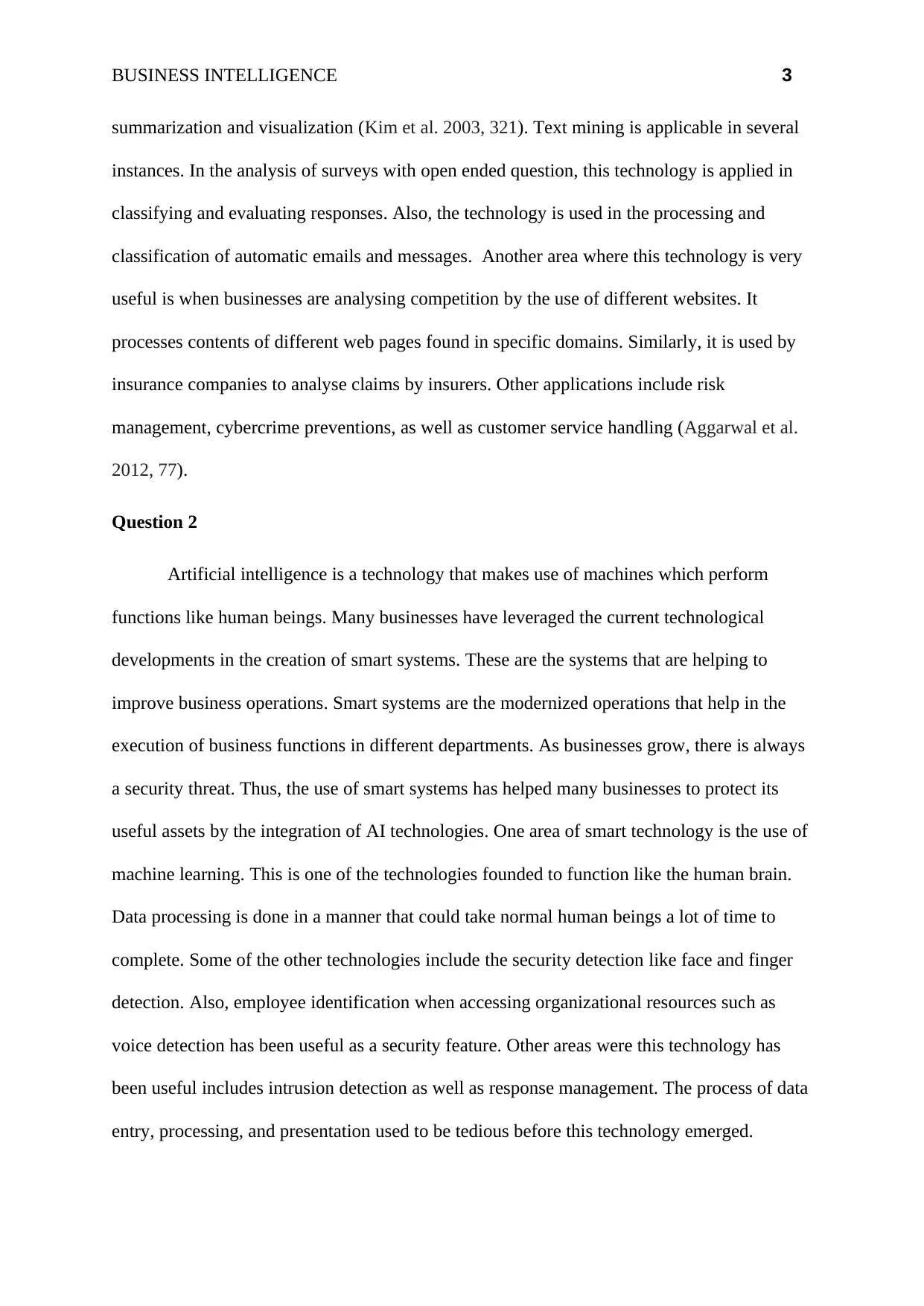
BUSINESS INTELLIGENCE 3
summarization and visualization (Kim et al. 2003, 321). Text mining is applicable in several
instances. In the analysis of surveys with open ended question, this technology is applied in
classifying and evaluating responses. Also, the technology is used in the processing and
classification of automatic emails and messages. Another area where this technology is very
useful is when businesses are analysing competition by the use of different websites. It
processes contents of different web pages found in specific domains. Similarly, it is used by
insurance companies to analyse claims by insurers. Other applications include risk
management, cybercrime preventions, as well as customer service handling (Aggarwal et al.
2012, 77).
Question 2
Artificial intelligence is a technology that makes use of machines which perform
functions like human beings. Many businesses have leveraged the current technological
developments in the creation of smart systems. These are the systems that are helping to
improve business operations. Smart systems are the modernized operations that help in the
execution of business functions in different departments. As businesses grow, there is always
a security threat. Thus, the use of smart systems has helped many businesses to protect its
useful assets by the integration of AI technologies. One area of smart technology is the use of
machine learning. This is one of the technologies founded to function like the human brain.
Data processing is done in a manner that could take normal human beings a lot of time to
complete. Some of the other technologies include the security detection like face and finger
detection. Also, employee identification when accessing organizational resources such as
voice detection has been useful as a security feature. Other areas were this technology has
been useful includes intrusion detection as well as response management. The process of data
entry, processing, and presentation used to be tedious before this technology emerged.
summarization and visualization (Kim et al. 2003, 321). Text mining is applicable in several
instances. In the analysis of surveys with open ended question, this technology is applied in
classifying and evaluating responses. Also, the technology is used in the processing and
classification of automatic emails and messages. Another area where this technology is very
useful is when businesses are analysing competition by the use of different websites. It
processes contents of different web pages found in specific domains. Similarly, it is used by
insurance companies to analyse claims by insurers. Other applications include risk
management, cybercrime preventions, as well as customer service handling (Aggarwal et al.
2012, 77).
Question 2
Artificial intelligence is a technology that makes use of machines which perform
functions like human beings. Many businesses have leveraged the current technological
developments in the creation of smart systems. These are the systems that are helping to
improve business operations. Smart systems are the modernized operations that help in the
execution of business functions in different departments. As businesses grow, there is always
a security threat. Thus, the use of smart systems has helped many businesses to protect its
useful assets by the integration of AI technologies. One area of smart technology is the use of
machine learning. This is one of the technologies founded to function like the human brain.
Data processing is done in a manner that could take normal human beings a lot of time to
complete. Some of the other technologies include the security detection like face and finger
detection. Also, employee identification when accessing organizational resources such as
voice detection has been useful as a security feature. Other areas were this technology has
been useful includes intrusion detection as well as response management. The process of data
entry, processing, and presentation used to be tedious before this technology emerged.
⊘ This is a preview!⊘
Do you want full access?
Subscribe today to unlock all pages.

Trusted by 1+ million students worldwide
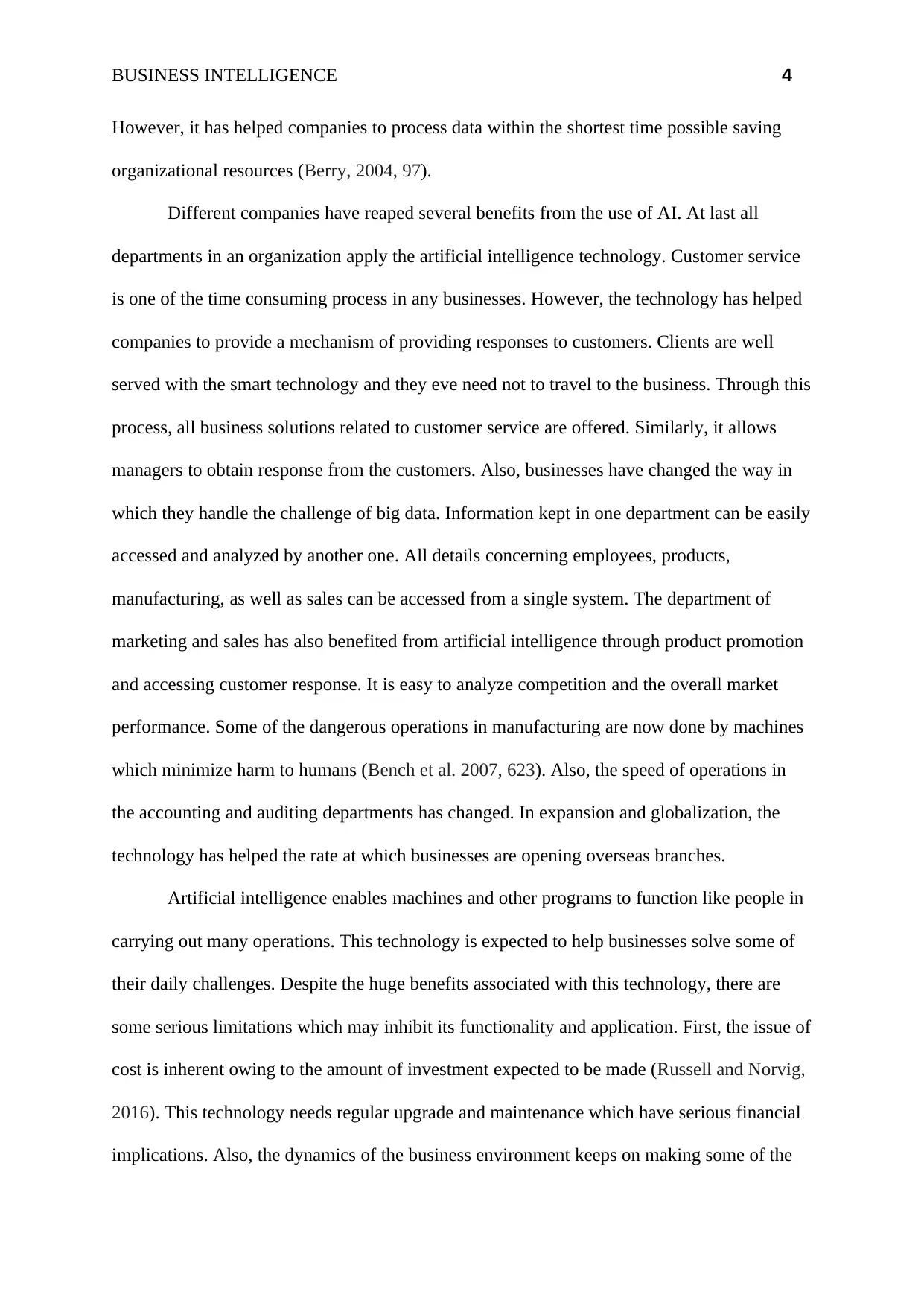
BUSINESS INTELLIGENCE 4
However, it has helped companies to process data within the shortest time possible saving
organizational resources (Berry, 2004, 97).
Different companies have reaped several benefits from the use of AI. At last all
departments in an organization apply the artificial intelligence technology. Customer service
is one of the time consuming process in any businesses. However, the technology has helped
companies to provide a mechanism of providing responses to customers. Clients are well
served with the smart technology and they eve need not to travel to the business. Through this
process, all business solutions related to customer service are offered. Similarly, it allows
managers to obtain response from the customers. Also, businesses have changed the way in
which they handle the challenge of big data. Information kept in one department can be easily
accessed and analyzed by another one. All details concerning employees, products,
manufacturing, as well as sales can be accessed from a single system. The department of
marketing and sales has also benefited from artificial intelligence through product promotion
and accessing customer response. It is easy to analyze competition and the overall market
performance. Some of the dangerous operations in manufacturing are now done by machines
which minimize harm to humans (Bench et al. 2007, 623). Also, the speed of operations in
the accounting and auditing departments has changed. In expansion and globalization, the
technology has helped the rate at which businesses are opening overseas branches.
Artificial intelligence enables machines and other programs to function like people in
carrying out many operations. This technology is expected to help businesses solve some of
their daily challenges. Despite the huge benefits associated with this technology, there are
some serious limitations which may inhibit its functionality and application. First, the issue of
cost is inherent owing to the amount of investment expected to be made (Russell and Norvig,
2016). This technology needs regular upgrade and maintenance which have serious financial
implications. Also, the dynamics of the business environment keeps on making some of the
However, it has helped companies to process data within the shortest time possible saving
organizational resources (Berry, 2004, 97).
Different companies have reaped several benefits from the use of AI. At last all
departments in an organization apply the artificial intelligence technology. Customer service
is one of the time consuming process in any businesses. However, the technology has helped
companies to provide a mechanism of providing responses to customers. Clients are well
served with the smart technology and they eve need not to travel to the business. Through this
process, all business solutions related to customer service are offered. Similarly, it allows
managers to obtain response from the customers. Also, businesses have changed the way in
which they handle the challenge of big data. Information kept in one department can be easily
accessed and analyzed by another one. All details concerning employees, products,
manufacturing, as well as sales can be accessed from a single system. The department of
marketing and sales has also benefited from artificial intelligence through product promotion
and accessing customer response. It is easy to analyze competition and the overall market
performance. Some of the dangerous operations in manufacturing are now done by machines
which minimize harm to humans (Bench et al. 2007, 623). Also, the speed of operations in
the accounting and auditing departments has changed. In expansion and globalization, the
technology has helped the rate at which businesses are opening overseas branches.
Artificial intelligence enables machines and other programs to function like people in
carrying out many operations. This technology is expected to help businesses solve some of
their daily challenges. Despite the huge benefits associated with this technology, there are
some serious limitations which may inhibit its functionality and application. First, the issue of
cost is inherent owing to the amount of investment expected to be made (Russell and Norvig,
2016). This technology needs regular upgrade and maintenance which have serious financial
implications. Also, the dynamics of the business environment keeps on making some of the
Paraphrase This Document
Need a fresh take? Get an instant paraphrase of this document with our AI Paraphraser
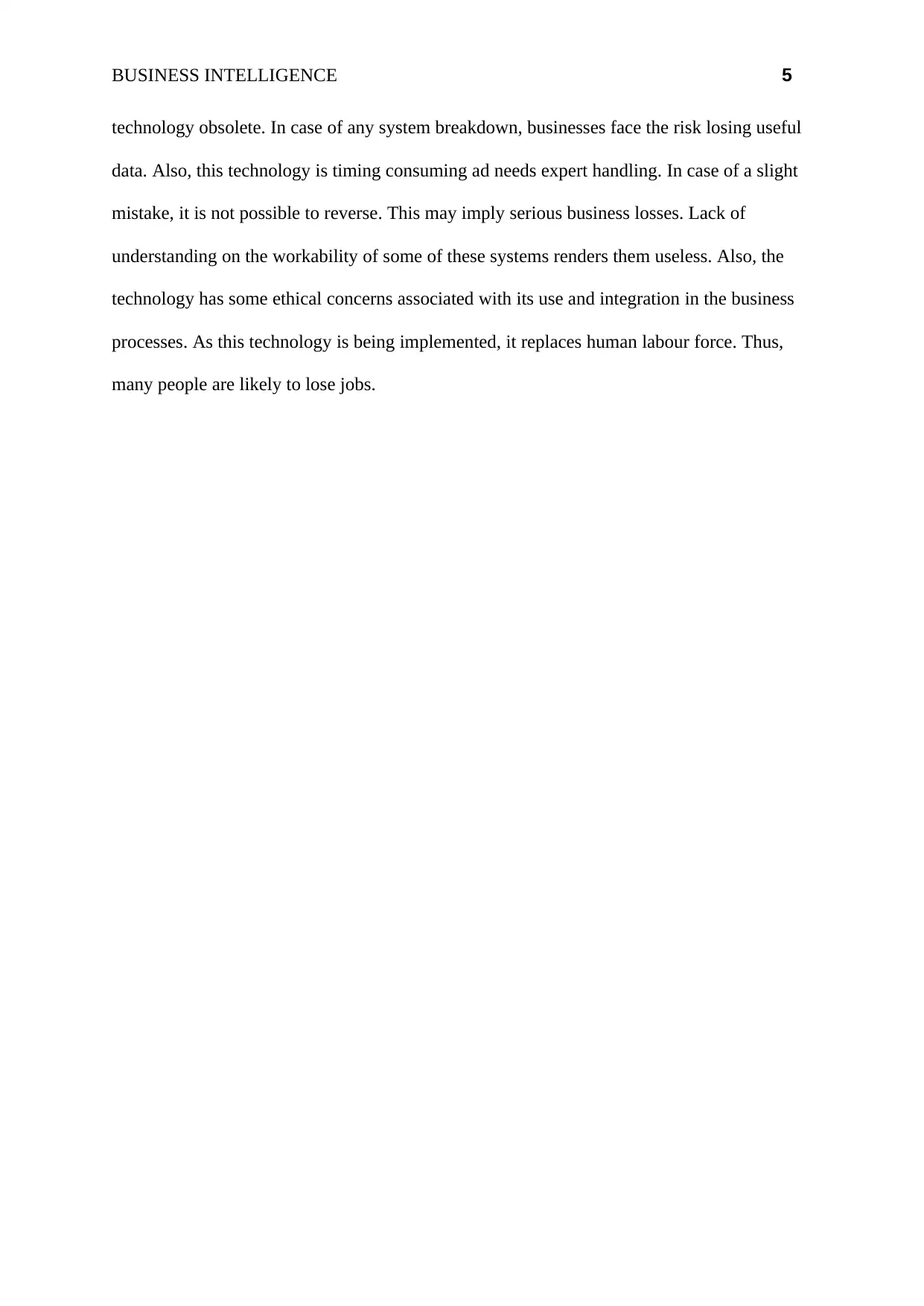
BUSINESS INTELLIGENCE 5
technology obsolete. In case of any system breakdown, businesses face the risk losing useful
data. Also, this technology is timing consuming ad needs expert handling. In case of a slight
mistake, it is not possible to reverse. This may imply serious business losses. Lack of
understanding on the workability of some of these systems renders them useless. Also, the
technology has some ethical concerns associated with its use and integration in the business
processes. As this technology is being implemented, it replaces human labour force. Thus,
many people are likely to lose jobs.
technology obsolete. In case of any system breakdown, businesses face the risk losing useful
data. Also, this technology is timing consuming ad needs expert handling. In case of a slight
mistake, it is not possible to reverse. This may imply serious business losses. Lack of
understanding on the workability of some of these systems renders them useless. Also, the
technology has some ethical concerns associated with its use and integration in the business
processes. As this technology is being implemented, it replaces human labour force. Thus,
many people are likely to lose jobs.
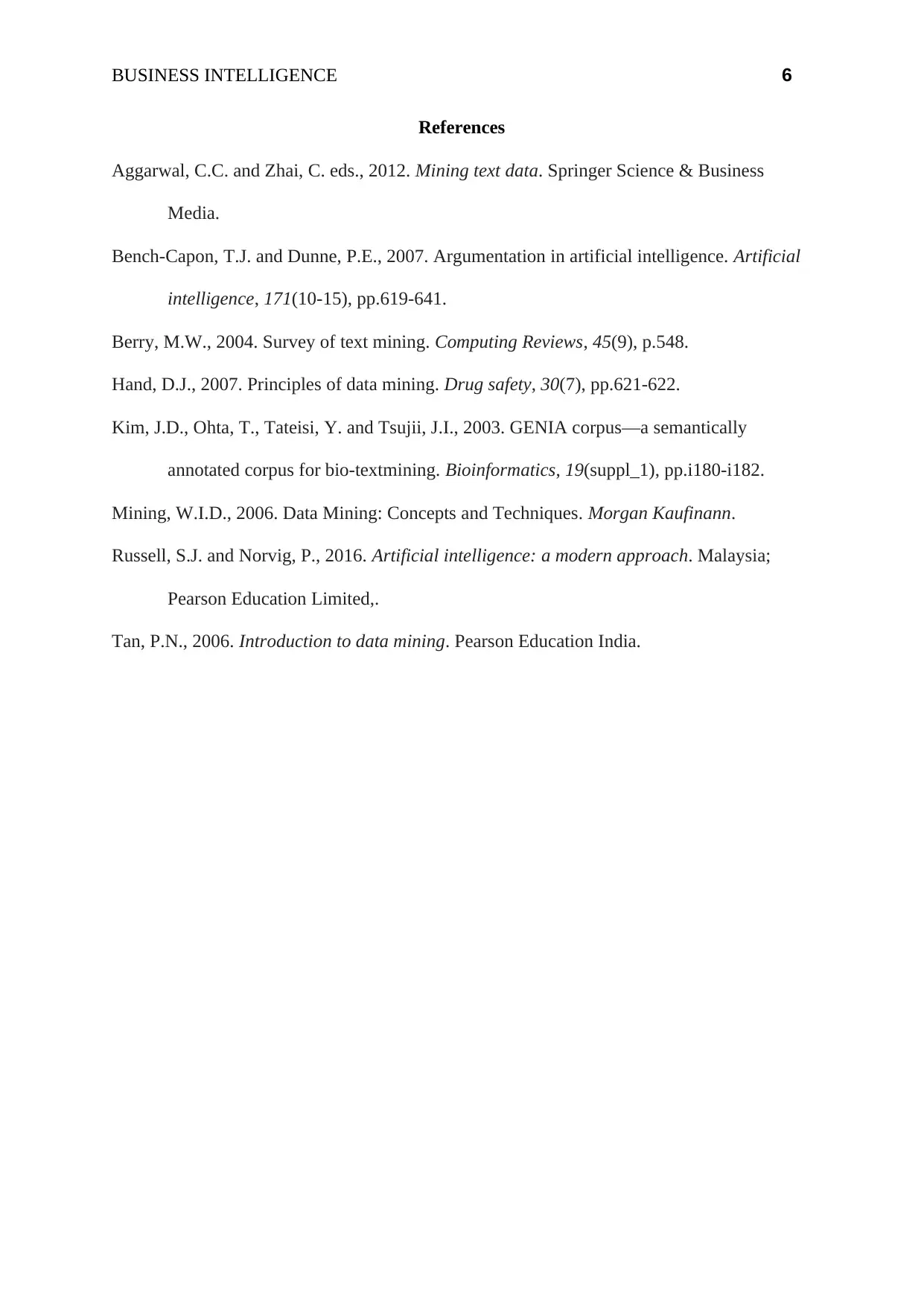
BUSINESS INTELLIGENCE 6
References
Aggarwal, C.C. and Zhai, C. eds., 2012. Mining text data. Springer Science & Business
Media.
Bench-Capon, T.J. and Dunne, P.E., 2007. Argumentation in artificial intelligence. Artificial
intelligence, 171(10-15), pp.619-641.
Berry, M.W., 2004. Survey of text mining. Computing Reviews, 45(9), p.548.
Hand, D.J., 2007. Principles of data mining. Drug safety, 30(7), pp.621-622.
Kim, J.D., Ohta, T., Tateisi, Y. and Tsujii, J.I., 2003. GENIA corpus—a semantically
annotated corpus for bio-textmining. Bioinformatics, 19(suppl_1), pp.i180-i182.
Mining, W.I.D., 2006. Data Mining: Concepts and Techniques. Morgan Kaufinann.
Russell, S.J. and Norvig, P., 2016. Artificial intelligence: a modern approach. Malaysia;
Pearson Education Limited,.
Tan, P.N., 2006. Introduction to data mining. Pearson Education India.
References
Aggarwal, C.C. and Zhai, C. eds., 2012. Mining text data. Springer Science & Business
Media.
Bench-Capon, T.J. and Dunne, P.E., 2007. Argumentation in artificial intelligence. Artificial
intelligence, 171(10-15), pp.619-641.
Berry, M.W., 2004. Survey of text mining. Computing Reviews, 45(9), p.548.
Hand, D.J., 2007. Principles of data mining. Drug safety, 30(7), pp.621-622.
Kim, J.D., Ohta, T., Tateisi, Y. and Tsujii, J.I., 2003. GENIA corpus—a semantically
annotated corpus for bio-textmining. Bioinformatics, 19(suppl_1), pp.i180-i182.
Mining, W.I.D., 2006. Data Mining: Concepts and Techniques. Morgan Kaufinann.
Russell, S.J. and Norvig, P., 2016. Artificial intelligence: a modern approach. Malaysia;
Pearson Education Limited,.
Tan, P.N., 2006. Introduction to data mining. Pearson Education India.
⊘ This is a preview!⊘
Do you want full access?
Subscribe today to unlock all pages.

Trusted by 1+ million students worldwide
1 out of 6
Related Documents
Your All-in-One AI-Powered Toolkit for Academic Success.
+13062052269
info@desklib.com
Available 24*7 on WhatsApp / Email
![[object Object]](/_next/static/media/star-bottom.7253800d.svg)
Unlock your academic potential
Copyright © 2020–2025 A2Z Services. All Rights Reserved. Developed and managed by ZUCOL.





